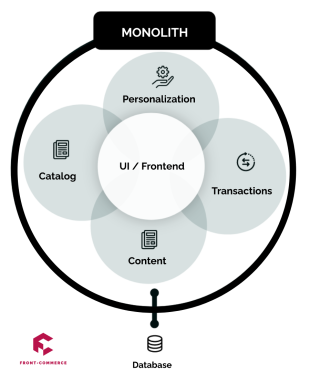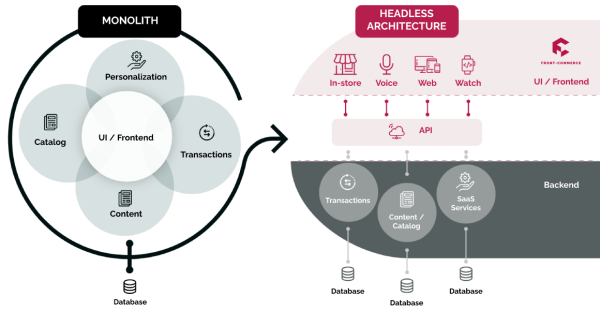E-commerce is a booming industry. Every day, more and more people buy and sell products and services online. This trend has led to the development of sophisticated e-commerce architectures.
Microservices are becoming more and more popular as an architecture for distributed systems such as e-commerce. But what are they, and why would you want to use them? In this post, we’ll look at microservices, their benefits, and moving to a microservices architecture without disrupting your entire platform.
4 benefits of microservices for e-commerce
- Greater scalability
- Faster development
- Increased flexibility for engineering & business teams
- Improved fault tolerance
Learn about the Front-Commerce micro frontend
What are microservices?
Microservices architecture is a term used to describe how an application is structured. With this type of architecture, the application is divided into many small services that work together to complete a task. They are small, self-contained services that communicate with each other using APIs. This style of architecture has become popular in recent years because it allows for more flexibility and scalability.
An e-commerce architecture is a system that enables businesses to sell products and services online. It typically consists of a backend and front-end MACH. The backend is responsible for managing the products and services, while the front-end is responsible for displaying them to customers.
When moving to a microservices architecture, there are a few things you will need to consider. First, you will need to decide how to divide your application into services. There are many ways to do this, so you will need to find the best approach for your specific application. You also need to make sure that you can deploy each service independently. This means that each service needs its runtime environment and database.
There are two main types of e-commerce architectures: monoliths and microservices. A monolith is a single entity that handles all aspects of an e-commerce system. A microservice, on the other hand, is a collection of small services that work together to handle specific tasks.

Monoliths have been around for longer than microservices and are generally simpler to develop and deploy. However, they can be difficult to scale as they become increasingly complex. Microservices offer greater scalability due to their modularity but can initially be more challenging to develop.
So which type of architecture should you choose for your business? The answer depends on your needs and preferences. Monoliths are ideal for smaller businesses with limited resources, while microservices are better suited for larger organizations with complex requirements.
The benefits of moving to microservices
Regardless of which type of architecture you choose for your e-commerce, there are several benefits of moving to microservices:
Greater Scalability
As mentioned earlier, microservices offer greater scalability than monoliths due to their modularity. Evolving your e-commerce platform as your business needs change requires less development time and costs once a microservices architecture is put in place.
Faster Development Time
Developing applications in a modular fashion makes it easier to identify dependencies and break down problems into manageable chunks. This leads to faster development times overall.
Increased Flexibility
With microservices, you can easily swap out individual components without affecting the rest of the system. This allows you to adapt quickly as your business evolves.
Improved Fault Tolerance
By splitting up functionality into independent modules, failures in one module will not bring down the entire system.
Moving to a microservices architecture with Front-Commerce
With a microservices architecture for e-commerce, both business and engineering teams are able to independently develop, test, address, deploy and update content, features, integrations & services. This leads to faster deployment and time-to-market, ultimately generating business growth.
With the implementation of their e-commerce front-end, Front-Commerce propose a microservices architecture. The decoupling of your storefront from your existing back-end is part of the service, and a MACH architecture is put in place.

Match a powerful front-end with best-of-breed integrations that perfectly meet the needs of your business. Each integration connects to your existing back-end via APIs & cloud technology giving you a new level of control over your online store. With the Front-Commerce approach, you can manage all aspects of your e-commerce services from one central location and you’ll also have total flexibility in terms of how your store looks and operates.
